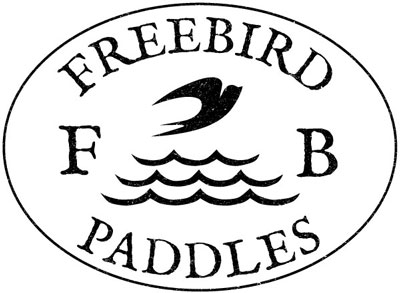Paddle Care Guide
On the matter of oiling wood, an old adage advises …“Once a day for a week, once a week for a month, once a month for a year…and once a year for the rest of its life!” As far as paddle care goes, this may seem over-the-top, but the sentiment holds. Our own paddles get cleaned & oiled after virtually every trip. Here at Freebird Paddles we have taken care of the 1st week for you as your paddle comes with at least 5 oil coats applied. You should regularly maintain the integrity of the waterproofing of your paddle. How often you do this is up to you, but be advised; it does need done! If a loose maintenance schedule is adhered to, your paddle should be fit for service for many years. Don’t wait until it is a matter of urgency, but rather stay ahead of the effects of weathering and general wear & tear. As well as looking good & being waterproof, your paddle will feel nicer & perform better.
Clean the paddle with a damp cloth & dry it. Then either;
Apply a couple of thin coats of Danish Oil (the Rustin’s and Liberon brands are our personal favourites) with a small clean (3” sq.) lint-free cloth (an old white cotton T-shirt cut up is ideal for the purpose), wiping in the direction of the grain: wait 10 minutes after each coat and then wipe off any excess oil with another clean rag (if you keep the coat thin & even, there will be no excess). It is advisable to wear thin nitrile-type gloves for the oiling to save on hand-cleaning. Ideally the oiling should be done in a warm, dust-free, ventilated environment. If the temperature is below 15c, gently warming (not boiling) the oil prior to application will aid in absorption (don’t heat the whole tin/bottle, but rather just what you will need…about 10mls per paddle per coat). Leave the paddle to dry between applications (12 – 24hrs), and polish it up after the top-coat has dried by buffing with a suitable lint-free cloth…any sticky patches (usually caused by too much oil or overlapping) will require an extra bit of effort to buff-out. A puff of warm breath on the area can help here as it will soften the oil build-up.
If damage has been sustained, or the wood has become bare and started to “fluff-up”, sand out any dents, scuffs and/or raised grain with some 120grit sandpaper; always working up & down (never across) the paddle in the direction of the grain. A flexible fine grade sanding pad (available from decorator’s suppliers and most DIY chain stores) is great for an all-over fine sand…as these are soft & supple, they prevent flat-spotting any surfaces and can be washed out after use. When satisfied it is scratch & scuff free, dust it down (a vacuum with dusting brush attachment is good for this). Now, apply 3 or 4 thin coats of oil in the manner described above. The wood will let you know when it’s had enough by no longer absorbing any oil.
If heavy damage has been sustained, please get in touch (with photos attached) and we will advise an appropriate course of action on an individual basis.
Your paddle should never be:
used to push-off from rocks & jetties or for poling through rapids and over ledges
used in white-water (unless it is a model with a glass reinforced blade, tip & edge)
stored away whilst wet or damp
left in direct sunlight (a damp paddle left exposed in a hot vehicle can be a recipe for disaster!)
kept anywhere too warm
kept anywhere too cold
allowed to become bare & devoid of oil
Ideally, your paddle should be stored hung by its handle & transported in a paddle bag.
If you look after your paddle, it will look after you many times over.
